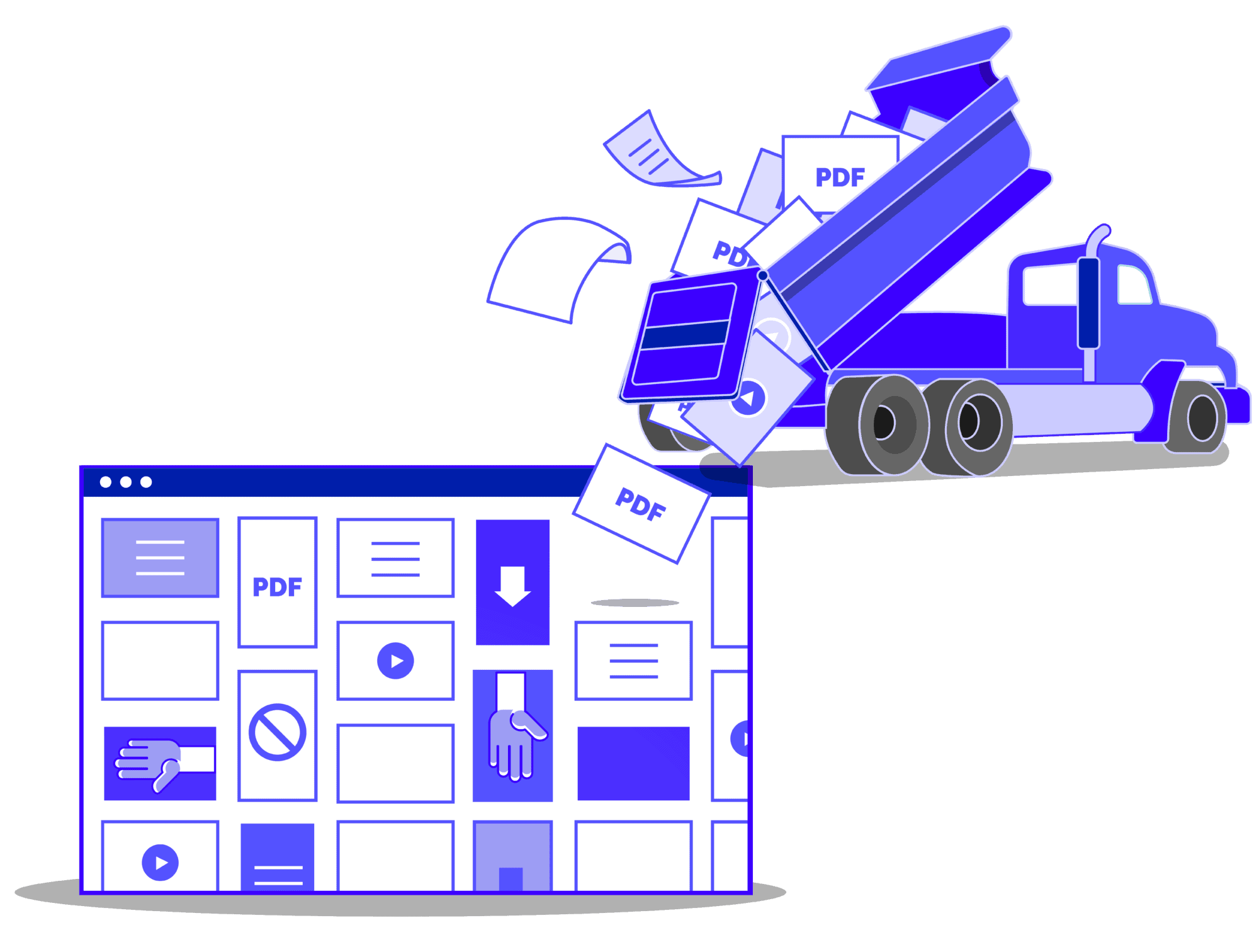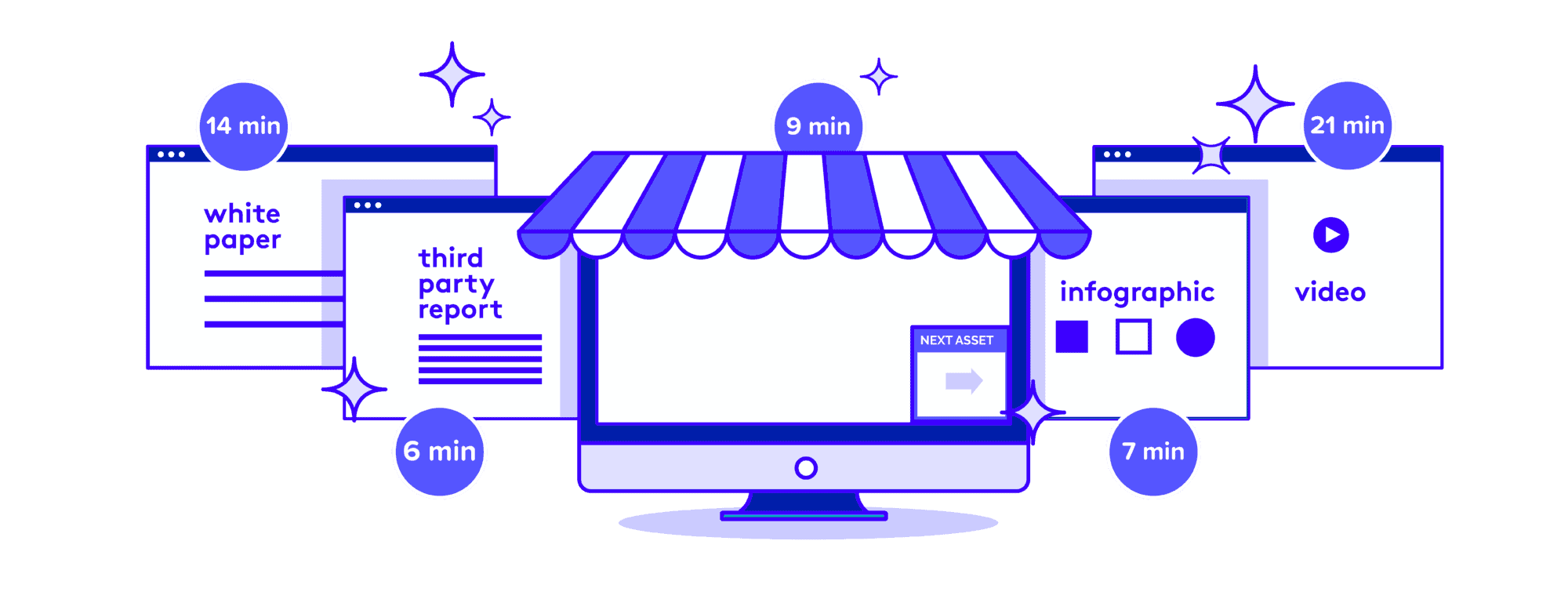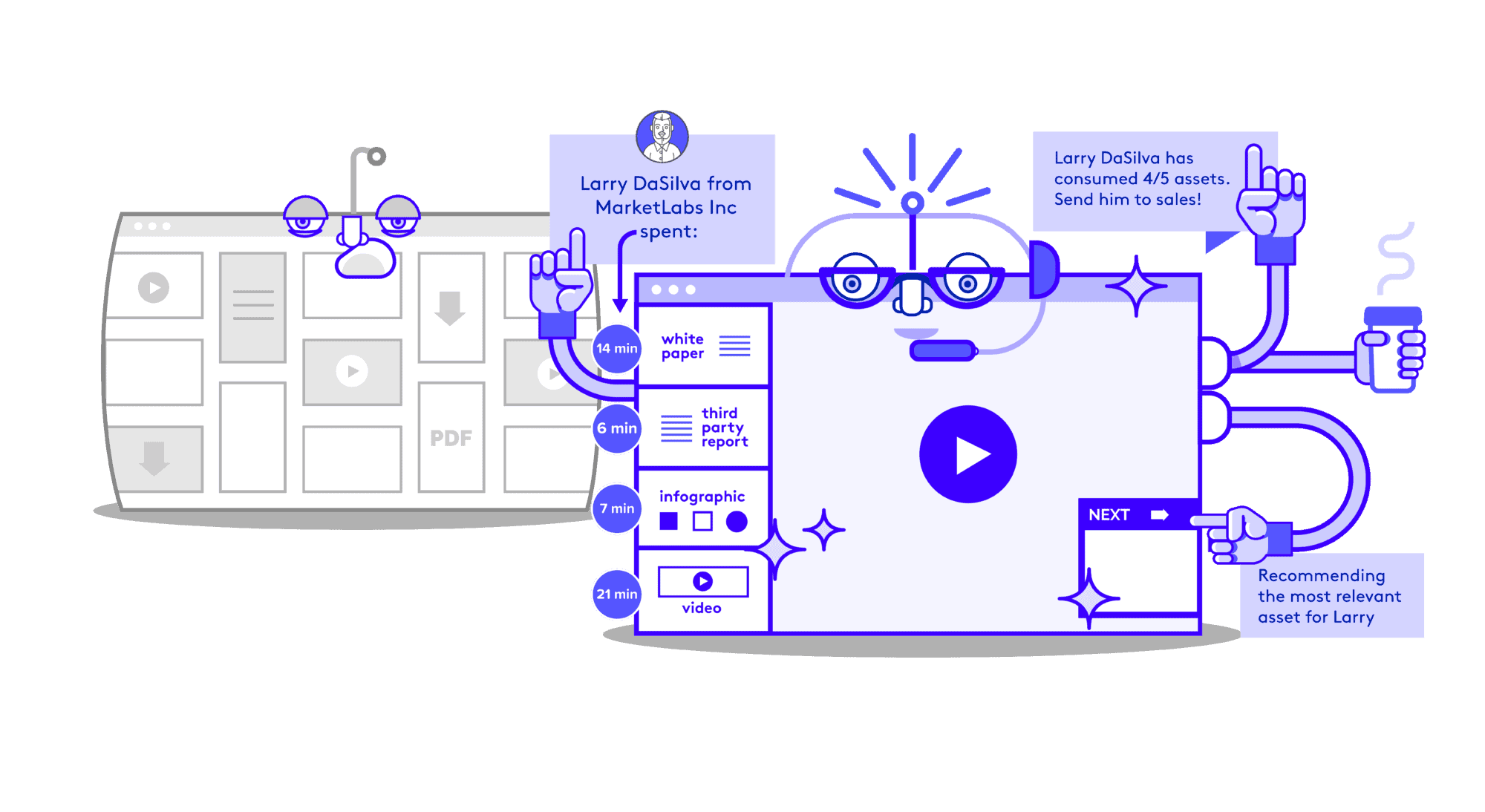Advance Sales And Customer Enablement With Content Intelligence

How B2B takes the ‘marketing’ out of ‘content marketing’
Passive content experiences are killing your marketing. There, we said it.
Passive content and one-and-done experiences often happen because we need a way to get all the expensive, insight-rich, nurture-flow-progressing content we create in front of the eyeballs we want.
So for years, B2B marketers tried to do this by emailing it out, piece by piece, or keeping it on-call for a drip campaign.
We locked it up on product pages where only some visitors might see it. We stuck it in a content hub so people could theoretically come and browse.
These passive content experiences aren’t the best you can do with all your great content.
And all of this makes sense. But what doesn’t make sense is thinking that these passive content experiences are the best you can do with all that great content.
Content is a strategic asset. So rather than expecting the right people to find it, marketers must find the right way to put it in front of the right people at the right time. This way, it becomes part of a directed journey instead of an aimless browse. Actively serving it to prospects actually gives you a chance at seeing a return on that investment–and not just when it’s first published, but for as long as it’s still relevant to your audience.

The perils of passive content experiences
Passive content experiences are both a bad customer experience and poor demand generation. There are several reasons for this:
They’re a game of chance
Passive content experiences rely on the idea that visitors are motivated enough to browse and poke around until they find what they’re looking for. That’s like playing a game of content poker! Will the stars align to help them find the right combination of content in time?
Instead, active content experiences are scientifically targeted, so you know you’re serving the right person, the right content, in the right place, and at the right time.
When you think about how most people find and consume information, heading straight to your content hub or eagerly awaiting your next email isn’t exactly at the top of their list. Passive experiences simply don’t meet buyers in the places where and when they are craving more information–and with the advent of on-demand B2C giants like Netflix, that’s what customers expect.
Difficult to discern what qualifies as high-engaging content
Passive content experiences don’t distinguish which assets are most relevant or ‘high value’ compared to others. You likely only have the ability to pin your most recent or hottest content to the top of a hub. The sad truth is that most content is buried deep in your website, hiding behind gates and forms. Or even worse, in an internal content library not available to the public. Passive content experiences fail your prospects in a variety of ways:
They assume one-size-fits-all
Totally ignoring who each prospect is and what they’re really interested in.
Making no relevant content recommendations for continuing their self-education. (Beyond ‘Other Recent Posts’ or ‘Popular Content’ CTAs.)
They’re not instrumented
Passive experiences don’t “listen” for you. If you don’t listen to what your visitors are telling you, you won’t know what they’re interested in and how deep or urgent that interest is. Web analytics aside, passivity prevents you from building up prospect or account data and insight that you can act on.
In short, passive content experiences are okay for casual web visitors who are happy to wander around, but terrible for motivated prospects who expect and deserve more from you.
They’re also terrible for marketing teams that need to take prospects by the hand, give them the most relevant information to help them make a confident buying decision, then deliver them to the sales team when they’re actually qualified to buy. This linear, goal-directed activity may be mainly buyer-controlled, but it’d better not be random. And randomness is the essence of passive content experiences.
So what is the solution for the passive content experience problem?
Don’t get us wrong, we’re not saying ditch email nurture and content hubs altogether. We’re just saying we need to be smarter about how we’re utilizing them. You do need some kind of content library or resource center on your website. But don’t rely on the expectation that motivated buyers will spend time to find and sift through mountains of random content.
You need to merchandize (think: the stockroom at IKEA).
Content merchandizing is all about stealing the best ideas from eCommerce retailers. It treats content as a valuable, money-making thing — not as inert clumps of stuff some prospect may one day trip over.

And before you point it out, yes, even PathFactory has had and will have a resources library on our website. It’s instrumented so we capture the content each visitor reads and attach that data to their profile. But it’s still a passive content hub. People can navigate to it on the website, but we never send people there as a destination.
And here’s a big difference: as soon as you click on any piece of content in our ‘hub’, on a paid ad, social post, or email, you’re launched into a completely different kind of experience. One click lands you in a carefully ‘merchandised’, predefined Content Track that does some important things:
- Serves you the content you clicked on and then recommends you the next logical piece based on your interests and stage in the buying process.
- Tracks the time you spend – down to the second – with each content asset and with the content track as a whole.
- Responds to exit signals with a new, targeted content recommendation to keep you on-site and consuming for longer.
- Asks for information only once you’ve shown enough active engagement to warrant that.
- Triggers the next best action to keep the engagement going.
All of these things are the opposite of passive.
The only way to overcome the passive content problem in B2B marketing is to activate it. Active content experiences are so much more valuable — for both prospect and marketer.
Content Activation wins every time.
We call this approach Content Activation because that’s exactly what it does: turns otherwise passive content, sitting on a dusty digital shelf, into hardworking assets that play an active role in your revenue operation.
Content Activation enables your buyers to find the information they need with as few obstacles as possible.
At its heart, Content Activation is about adapting to the way your buyers actually conduct their research — and eliminating any obstacles to the vital self-education process.
The idea is to connect buyers with the most relevant information, whenever or wherever they interact with you. It’s actively merchandizing your content the way Amazon actively merchandizes everything from books to toys and food to toilet paper, or the way Netflix merchandizes shows and movies for you to watch.

With Content Activation, you develop your audience’s appetite for your information, then detect that hunger and act on it. We call this hunger Engaged Intent and it’s the most reliable signal of sales-readiness for any B2B marketer. (Demographics, such as job title, industry, or company size, do not signal buying intent. Even simple intent signals like Google searches or web hits are far more superficial than the kind of content bingeing you see when Content Activation is used.)
Demographics, Google searches, and website visits do not signal real buying intent.
If Engaged Intent is urgent, committed hunger for information that really signals a hot prospect, we marketers need to seize the opportunity by serving up the next best content or offer. Not ‘another piece of random content that may or may not relate to this buyer’. The best content for this specific opportunity right now.
Passive content experiences don’t do this because they can’t do it. They simply were never designed to even notice much less act on data as powerful as Engaged Intent. They were designed to solve a marketer’s problem, not a prospect’s.
“We need somewhere to house our content; create a content hub!”
“We need our database to see this eBook; send a nurture touch…but only on Thursdays since it fits the marketing calendar!”
Content Activation puts your customer first.
“Steve spent over 10 minutes looking at content on Topic A. We should serve him more content on that and related topics!”
“Sally spent 3 minutes watching a 3.5 minute video. It’s probably a good time to serve the form for the eBook that dives deeper into those concepts!”
See the difference?
So, that’s our rant about passive content experiences and our call for marketers to be better, do better. You can do this by promoting active content consumption and never subjecting your hottest leads to a passive browsing experience ever again. Because your prospects and customers deserve it.
